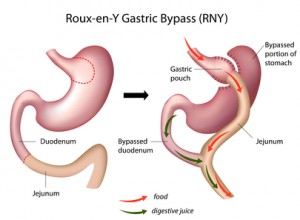About Bariatric Conversion Surgery
 Bariatric conversion surgery also known as weight loss conversion, is an assortment of procedures performed on obese people.
Bariatric conversion surgery also known as weight loss conversion, is an assortment of procedures performed on obese people.
The key objectives for this type of surgery are:
1) Reduction of stomach size. This is a type of restrictive surgery. It reduces the quantity of food held in the stomach, making one get a feeling of fullness much sooner than before. It includes; the reduction of the volume of transoral gastric, adjustment of the gastric sleeve and vertical banded gastroplasty.
2) Malabsorptive surgeries which involve rearrangement or partial removal of an individual’s digestive system. This in turn limits the volume of nutrients and calories a person can absorb.
3) Combining malabsorptive and restrictive techniques. This involves a duodenal switch. It involves re-routing and resecting of the small intestines to a minute stomach pouch.
Types of bariatric conversion surgery:
1) Gastric banding. This procedure involves placing a ring at the upper echelons of a person’s stomach that results in the formation of a minute pouch that holds approximately half a cup of food, thus reducing the consumption of food. By being adjustable, a small opening resulting in delay of passage of food and distribution of food throughout the stomach. This makes one have a feeling of fullness for a long time.
2) Gastric bypass. An egg-sized section of the stomach is surgically separated from the other part. The resulting smaller stomach restricts the quantity one can take in. The lower section of the stomach continues to help with digestion but will never hold food. The Y-shaped segment of a person lesser bowel is attached to the now reduced stomach. The rest of the bowel still remains attached to the lower stomach. This results in reduction of the intake of calories and hence weight loss.
3) Gastric sleeve resection. The intestines are not involved in the surgical procedure. A colossal section of the stomach is cut out, this leaves a thin section similar to a sleeve. This procedure does not alter the opening of the stomach thus digestion resumes normally. Gastric sleeve surgery is helpful in cases where patients looking to lose weight have health issues that would aggravate their problems. The procedure is not reversible.
4) Biliopancreatic diversion duodenal switch. This procedure involves a large section of the stomach being cut off, leading to the creation of a cylindrical shaped bag that connects the gullet to the top part of small intestines.
The section of the small intestines is removed, but the surgeon leaves a part of the duodenum or the upper section of the small intestines, where a lot of chemical digestion takes place still in touch with the stomach.
The small intestines are cut off several feet. The part still attached to the colon is joined to the duodenum.
The area where the small intestines are not attached to the stomach is then joined to the small intestines, so that the juices that aid in digestion produced can mix with in coming food from the stomach.
For professional advice and information contact Dr Castaneda.


